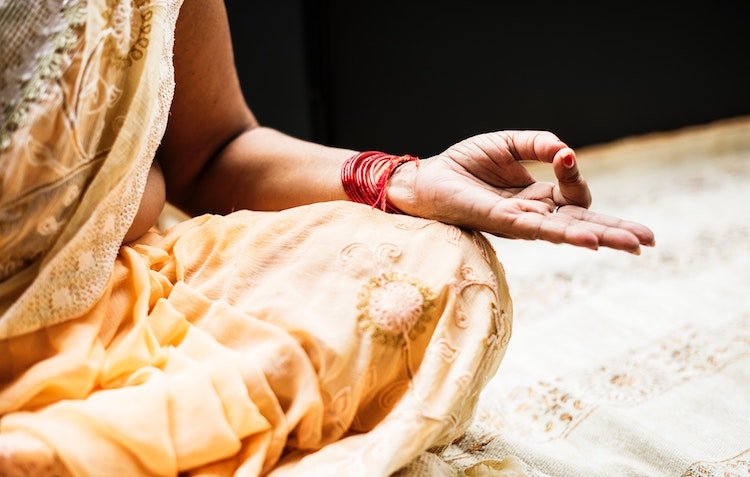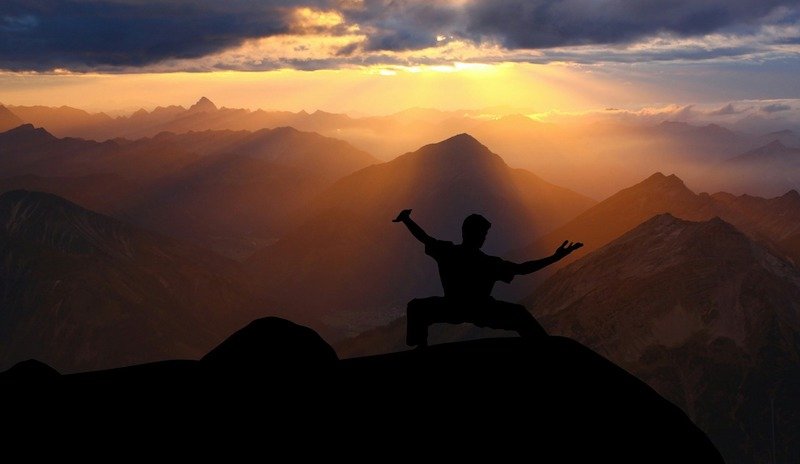There are many different types of meditation. Discovering which style suits you best is useful – you'll be more likely to devote yourself to the practice and so the health benefits will stay with you for longer. Calvin Holbrook looks at 10 common meditation types.
Meditation has surged in popularity in the Western world in recent years, and there seem to be an ever-increasing number of different types of meditation available to practise. While this can be confusing, what isn't at question is the world of good meditation provides. Indeed, if you've ever asked 'does meditation really work?', the answer is a resounding 'yes'!
In fact, research has shown that the effects of meditation include pain reduction, lowered blood pressure and an increased sense of well-being and self-compassion. However, while there are a host of positive claims for the benefits of meditation, many meditation myths and misconceptions remain and there is still a lot about this ancient practice that is not fully understood by science.
Indeed, meditation is sometimes presented by mainstream media as a cure-all. And while recent studies indicate that meditation is effective for anxiety and depression, it doesn't seem to be any more effective than other forms of treatment, such as medication or exercise. With this in mind, how do you decide on what type or style of meditation is best for you?
Choose a meditation type that's best for you
Commitment to a regular meditation practice is necessary in order to reap the full benefits. Indeed, it's essential to find a personal meditation style or technique that you're comfortable with. That's because finding your preferred form of meditation means you're more likely to continue with it. But, in fact, there's no right or wrong way to meditate. We suggest that you should choose a type that speaks to you spiritually. Try a few of these styles of meditation and see what you enjoy most.
Which type of meditation should I choose?
Below, we'll describe eight of the most common meditation types or techniques. Before reading on, ask yourself the following questions that will help you discover your best personal style of meditation:
- Are you trying to empty your mind or focus it?
- Do you find it easy to focus when sitting still or do you find it easier when active?
- Do you find sounds distracting or calming?
- Do you want others to benefit from your meditation practice also?
When assessing the effects of a particular style, you may find it helpful to keep a journal of your thoughts and feelings during and after a sitting. So, explore the ten meditation types listed below and find what works for you...
1. Focused meditation
Suitable for beginners and those who need assistance in focusing.
Science has shown that practising meditation over years can cause the grey matter in the brain to increase in area, so it's well worth finding a form of meditation that will help you persevere. The focused meditation style concentrates on the senses.
Visualization is when you focus on a mental image of an object, such as a light or a flower. This is a commonly-used technique. Occasionally you may be asked to focus on other senses, like sound or touch. Other focus points include breathing and the flow of energy through your body.
RELATED: Visualization Meditation – How to Practise It
2. Mantra meditation
One of the best meditation styles for those who find silence distracting and find relaxation and peace in repetition.
Mantra meditation has been practised for thousands of years. You simply chant or recite a 'mantra', such as the mystical Sanskrit word 'Om' (claimed to be the origin of all sound). Whether you whisper it mentally or chant aloud, repetition allows your mind to relax. Alternatively, you could choose an inspirational phrase that's personal to you. Mantra meditation can be practised in a group or individually.

Mantra meditation is a style for those who don't enjoy silence
3. Transcendental meditation (TM)
A meditation style that may suit a person looking for a more structured form. Or committed beginners who are ready for a regular practice.
Founded by Maharishi Mahesh Yogi and with more than five million practitioners worldwide, transcendental meditation (TM) is the style which has received the most attention from science. For example, research by the AHA has shown that TM can reduce hypertension.
“Science has shown that practising a meditation technique over years can cause the grey matter in the brain to actually increase in area.”
Instead of just following the breath, transcendental meditation uses a series of Sanskrit words and mantras to help you focus. Every student is given an individual mantra, based on factors like gender or birth year. The recommendation for transcendental meditation is to practise it in a comfortable seated position, for 20 minutes twice a day. Vedic meditation is another variation.
4. Spiritual meditation
If you thrive in silence, spiritual meditation may be your best personal meditation style.
Science shows that spiritual meditation can be helpful in lowering high blood pressure and preventing heart disease. Similar to prayer, spiritual meditation allows the practitioner to reach a more reflective and contemplative state through various elements.
RELATED: What Is a Sound Bath Meditation and What Are Its Benefits?
Whether at home or in a place of worship, you embrace the silence and gradually allow your mind to wander over a personal question or prayer. Some people find that the answer to their deepest questions comes from within. While others feel that they answer comes from outside – from God or the universe.
5. Mindfulness meditation
May suit someone who has no regular access to a group or teacher.
Buddhist teachings base themselves on mindfulness meditation. It's an umbrella term for meditation techniques that teach us to accept everything that arises without judgement. To address things that occur and release stress as it arises while nurturing a surrender to things that we cannot change.
RELATED: Outdoor Meditation: How to Meditate in Nature
Studies show that mindfulness meditation can be an effective treatment for episodes of depression. It's possible to practise this style of meditation alone, making it particularly suitable for those who do not have access to a class or teacher. Furthermore, like many styles of meditation, it requires minimal effort.

Mindful meditation is a perfect type for when you're alone
6. Gratitude meditation
May suit someone who wants to practise meditation at any time throughout the day.
Gratitude meditation is one of the easiest styles of meditation you can try and you can also practise it anywhere, even on the go. This meditation type involves meditating on the things you're thankful for and allowing that appreciative sensation to take a stronghold within. The benefits include greater sense of well-being, improved mental health and stronger personal relationships.
7. Vipassana meditation
For experienced meditators considering exploring even deeper within themselves.
Vipassana means 'to see things as they really are'. Vipassana is one of the most ancient techniques of meditation. In fact, it's believed to be the meditation form taught by the Buddha himself. Vipassana meditation is a method of self-transformation through self-observation and focuses on the deep interconnection between the mind and body.
“Commitment to a type of meditation is necessary in order to reap the full benefits. Indeed, it's essential to find a personal meditation style that you're comfortable with.”
Ten-day silent retreats where you can develop the Vipassana meditation technique are popular. Communication of any kind during these events is usually strictly prohibited. It’s recommended that if you want to try a ten-day retreat that you already have a basic knowledge of meditation and have experience in sustaining long periods of quiet and calm.
8. Six phase meditation
Ideal for those who want to boost compassion, happiness and productivity.
Six phase meditation is a newer meditation technique that combines the science behind how our brain works with advice on spiritual growth. This six-step guided meditation tackles common roadblocks in meditation practice and requires up to 20 minutes daily. This style of meditation involves meditating on the following six things: connection, gratitude, forgiveness, visualization, daily intention blessing.
The main goals of 6 phase meditation are lowering anxiety and stress, connecting with your intuitive and creative side, becoming more compassionate and fulfilled, and increasing happiness and productivity.
9. Movement meditation
May suit you if your mind becomes distracted when you're still. Or if you sit at a desk all day and prefer to find tranquillity through action.
Movement meditation is a broad category of active meditation styles. Gentle, repetitive movements such as hatha yoga, a walk through the woods during forest bathing, gardening, or even housework help to clear your mind and keep it in the moment. Research by scientists at Oregon University found a significant decrease in pain experienced by fibromyalgia patients who practised this meditation type.

Movement meditation suits active types of people
10. Loving kindness meditation
Ideal for those who want to boost compassion, connection and self-acceptance.
Loving kindness is a popular meditation technique used to increase capacity for forgiveness, connection and self-acceptance. During loving kindness, you focus loving energy toward yourself and to others – even those you make dislike or total strangers.
While meditating, try to imagine yourself experiencing complete wellness and inner peace. Feel perfect love for yourself, content that you're just right. While concentrating on this joyous feeling of love and kindness, repeat these positive phrases to yourself (or create your own):
- May I be happy
- May I be safe
- May I be healthy, peaceful, and strong
- May I give and receive appreciation today
Bask in those feelings of warmth and self-compassion for some moments before shifting your focus to loved ones. Start with someone who you're very close to, and feel your gratitude and love for them. Repeat the reassuring phrases for them: may you be happy and safe.
Next, branch out to other friends and family members and repeat the meditation technique. It's important to try it with people you may dislike or do not naturally connect with. Finally, extend feelings of loving kindness to people around the globe and focus on a feeling of connection and compassion. Tonglen meditation is a similar type of meditation and also shares a purpose of focussing on compassion and healing others.
Takeaway: types of meditation
There are a multitude of meditation techniques and styles to discover. Try practising a few different ones to see which are best suited to your lifestyle. For most people, meditation induces calmness, relaxation and a sense of well-being. Meditation should not be a optimization goal in-and-of itself but rather a means of developing self-compassion and peace. Be wary of pushing on with a meditation practice if it feels counter-productive. ●
Main image: Colorbox.com
happiness.com | The fine art of being: learn, practise, share
Are you a happiness.com member yet? Sign up for free now to:
■ enjoy our happiness magazine with practical life tips
■ share and support others in our happiness forum
Written by Calvin Holbrook
 Calvin edits our magazine and is a lover of swimming, yoga, dancing to house/techno, and all things vintage. Find out more.
Calvin edits our magazine and is a lover of swimming, yoga, dancing to house/techno, and all things vintage. Find out more.



Join the conversation
You are posting as a guest. If you have an account, sign in now to post with your account.